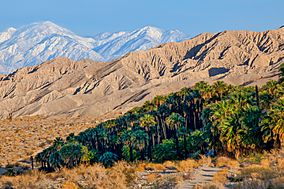Sand to Snow National Monument facts for kids
Quick facts for kids Sand to Snow National Monument |
|
|---|---|
 |
|
| Location | San Bernardino County, California, US |
| Area | 154,000 acres (62,000 ha) |
| Authorized | February 12, 2016 |
| Governing body | Bureau of Land Management, National Forest Service |
| Website | Sand to Snow National Monument |
The Sand to Snow National Monument is a special protected area in Southern California. It covers parts of San Bernardino County and Riverside County. This monument helps protect many different types of land. These include mountains and deserts. It is home to various plants and animals. The monument stretches across the San Bernardino Mountains, the southern Mojave Desert, and the northwestern Colorado Desert.
Contents
Exploring Sand to Snow's Landscape
This national monument is very large. It covers about 154,000 acres. The Bureau of Land Management (BLM) looks after 83,000 acres. The National Forest Service manages the other 71,000 acres. The land here changes a lot. It goes from about 1,000 feet high on the desert floor. Then it climbs up to over 11,000 feet in the San Bernardino Mountains.
Wilderness Areas and Trails
A big part of the monument, over 100,000 acres, is inside the San Gorgonio Wilderness. This area was set aside by Congress in 1964. The monument also touches Joshua Tree National Park on its eastern side. Another section adds to the Bighorn Mountain Wilderness area.
A famous hiking path, the Pacific Crest National Scenic Trail, runs through the monument. About 30 miles of this trail are here. Important rivers also start in this area. These include the Santa Ana River, Whitewater River, Morongo Creek, and San Gorgonio River. The monument is a vital pathway for wildlife. It connects the San Bernardino National Forest, San Gorgonio Wilderness, Joshua Tree National Park, and Bighorn Mountain Wilderness.
Amazing Plants and Animals
The Sand to Snow National Monument has many different plant groups. It is one of the richest national monuments for plants in the United States. You can find plants from the higher Mojave Desert and lower Sonoran Colorado Desert. There are also chaparral, California oak woodland, and pine forests. Even high-altitude alpine plants grow here.
Diverse Plant Life
The plants in the San Bernardino Mountains are special. This is because three different natural areas meet here. To the west, there are California chaparral and woodlands. To the east, you find the Mojave Desert. To the south, there is the Sonoran Desert. Because of this mix, over 1,600 different kinds of native plants live in these mountains.
Unique Wildlife
The monument is home to some unique animals. At lower elevations, in the sand dunes near the Whitewater and San Gorgonio Rivers, lives the endangered fringe-toed lizard. These lizards are specially adapted to sandy environments. Higher up in the mountains, you can find Desert bighorn sheep. These strong animals are known for their large, curved horns.
How the Monument Was Created
The Sand to Snow National Monument was officially created on February 12, 2016. President Obama made this decision. Two other national monuments, Castle Mountains National Monument and Mojave Trails National Monument, were also created at the same time. The monument is managed by two groups: the United States Forest Service and the Bureau of Land Management.
The idea for the Sand to Snow National Monument came from a group called The Wildlands Conservancy. For twenty years, they worked on a project to protect land. They bought over 60,000 acres of private land. This land was in danger of being built on. The Conservancy helped set up places like Whitewater Preserve, Mission Creek Preserve, and Pioneertown Mountains Preserve. The Big Morongo Canyon Preserve was protected in 1982. It was later included in the monument. This makes it one of the most developed areas within the monument.



